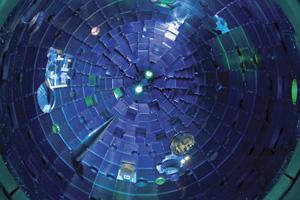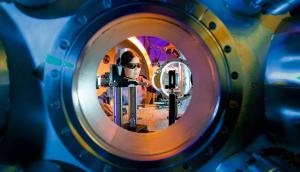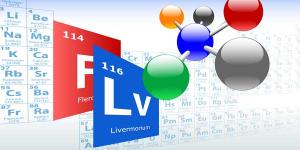LAB REPORT
Science and Technology Making Headlines
April 14, 2017


Laser beamlines at the National Ignition Facility entering the lower hemisphere of the NIF target chamber.
Ignition quest
Through the National Ignition Facility has yet to achieve ignition, the quest is on to achieve the controlled nuclear fusion reaction that produces more energy than is required to sustain it.
Lawrence Livermore scientists have found that it all comes down to symmetry and a different approach to the physics behind the process.
During a shot, the combined energy of the facility’s 192 laser beams is directed onto a hollow target, called a hohlraum, about one centimeter in height and a few millimeters in diameter. This target contains helium gas and, at its center, a tiny capsule filled with deuterium–tritium fuel. As the lasers heat the hohlraum, the gold coating on its interior surface begins to give off X-rays.
But the laser field outside the hohlraum is not perfectly symmetric. Neither is the X-ray field produced inside. Wherever such asymmetries exist, the pressure applied to the fuel capsule is slightly different. “You can think of it as like trying to squeeze a soccer ball down to something the size of a pea,” said NIF Director Mark Herrmann. “If you squeeze harder on one side or another you get a lima bean, or a string bean. You don’t get a pea.”


The U.S. used more renewable energy in 2016 compared to the previous year, according to the most recent energy flow charts released by Lawrence Livermore National Laboratory. Photo courtesy of National Renewable Energy Laboratory
Americans keep it clean
Americans kept it clean in 2016 by using more renewable energy compared to the previous year, according to the most recent energy flow charts released by Lawrence Livermore National Laboratory. Overall, energy consumption was nearly flat.
Each year, the Laboratory releases energy flow charts that illustrate the nation's consumption and use of energy. Americans used 0.1 quads (quadrillion BTU), more in 2016 than in 2015. A BTU, or British Thermal Unit, is a unit of measurement for energy; 3,400 BTU is equivalent to about 1 kilowatt-hour.
Coal, petroleum and natural gas continue to be the main sources of energy consumption in the United States, making up about 81 percent of U.S. energy consumption. But between 2015 and 2016, solar energy use rose by 38 percent, wind power rose by 19 percent and coal use declined by 9 percent, according to the chart.


A new Lawrence Livermore technology could mean the end to animal testing.
Good news for lab rats
Chemical testing on animals could be a thing of the past, thanks to a breakthrough in biochemical engineering. Scientists at Lawrence Livermore are growing human cells on computer chips, calling it “iCHIP.”
"The idea behind it is that this is a better medium because it uses human cells instead of animal testing," said biochemist Elizabeth Wheeler.
Human organ cells are grown on electrical sensors that can read electrical changes when different chemicals or drugs are added to the cells on the chip. Computers read the electrical changes that take place and give researchers an idea if a chemical is safe for humans.
The technology is already in use in epilepsy research and eventually the Lab will create a chip for every major organ in the human body.


Marcus Monticelli inspects the anti-reflective coating on a National Ignition Facility grating debris shield. Photo by Jason Laurea/LLNL
A boost to laser performance
Optics engineers at Lawrence Livermore’s National Ignition Facility (NIF) have developed a new anti-reflective coating for the giant laser system’s optics that could both boost the pulse energy delivered to the target chamber and cut the rate at which damaged components need to be replaced.
NIF scientists say that the new colloidal silica particle coating will help cut the need for replacement optics by more than half, and the optics team is currently three-quarters of the way to completing installation of the new technology.
Fabricated using a sol-gel chemical process, the coating was developed to reduce reflections from the rear surface of NIF’s grating debris shields (GDS). The GDS is the penultimate optic before the 192 laser beams enter the target chamber. It serves to protect other optics from the hostile target chamber environment.
LLNL engineers say that a patented fabrication method, which they call the “advanced mitigation process” (AMP), further protects the optics by making their surfaces more damage resistant through removing impurities and reducing microfractures.


Element 116 is named Livermorium after the Lawrence Livermore National Laboratory and the city of Livermore.
Superheavy lifting
Creating superheavy elements is quite simple. Smash together nuclei of two different elements, each with a sufficient number of protons and neutrons and hope they will fuse to form a new element. However, to overcome the repulsive force between the two positively charged colliding nuclei, ions of the lighter of the two elements are accelerated to almost a tenth of the speed of light in particle accelerators and beamed at a target made of the second element.
The credit for synthesizing the latest four new elements goes to the scientists from Japan, Lawrence LIvermore, Oak Ridge National Laboratory and Russia. Between 2000 and 2012, Japanese scientists at RIKEN Nishina Centre for Accelerator-Based Science created a new element of atomic number 113, which was later named Nihonium (Nh).
Lawrence Livermore partnered with Russia to create element 118 in 2002. Syntheses of elements 115 and 117 were carried out in collaborative research between the Joint Institute for Nuclear Research, Russia, and Lawrence Livermore National Laboratory, in 2003 and 2010, respectively.





